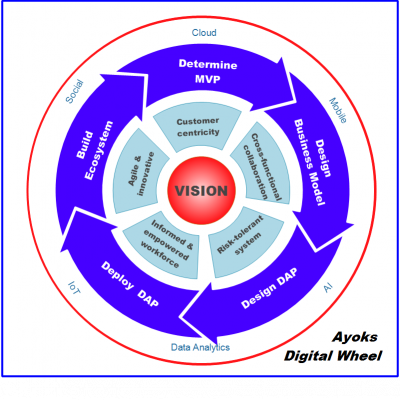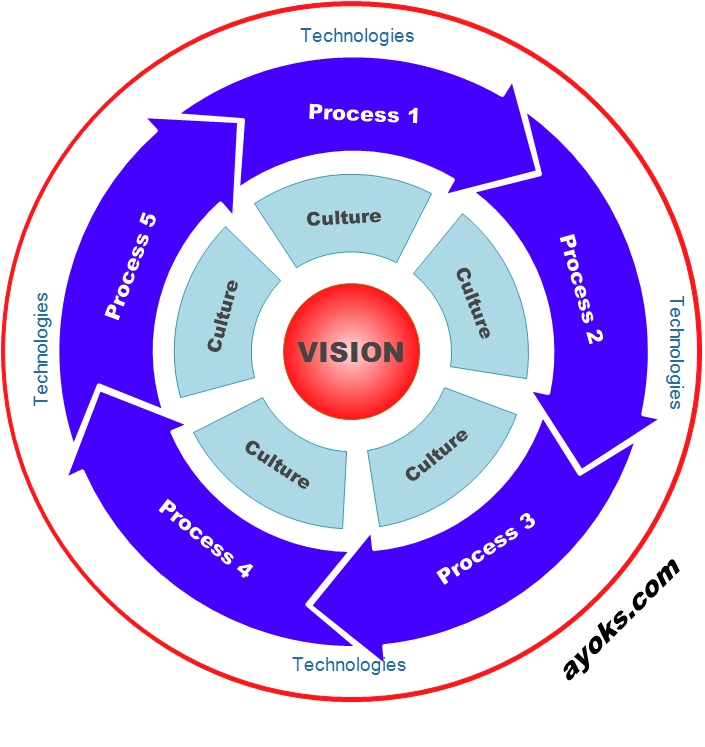DRIVING SUCCESSFUL DIGITAL TRANSFORMATION
In 2021, digital transformation undoubtedly is on the front burner for most businesses. The question is no longer whether to undertake digital transformation, the question is how to get it right. The pace of change in the business environment is on the increase, customers’ expectations are changing and market dynamics is radically changing; hence businesses must respond timely and adequately to remain competitive in the emerging digital world.
Most businesses have embarked on some form of digital transformation efforts, unfortunately many are not getting the desired result. According to a McKinsey Global survey, less than 30% of digital transformation projects succeed.
AYOKS DIGITAL MODEL
Ayoks Digital Model is a framework to guide successful digital transformation of businesses. It recommends a holistic and coordinated transformation program for businesses. It presents four elements as the core drivers of digital transformation, which must be strategically coordinated to achieve successful digital transformation.
It infers that successful digital transformations are centered around inspiring business vision, nurtured by the right organizational culture, follow iterative processes and are powered by one or more digital technologies. These are captured as different layers of the Ayoks digital wheel
VISION
At the center of every successful digital transformation project is an inspiring vision. Read more.
CULTURE
This transformation project must be supported by the right organisational culture. Read more
PROCESSES
Digital transformation is a journey and consists of several iterative processes. Read more
TECHNOLOGIES
Digital technologies provide the platform to enhance operational efficiency and fulfill customers’ needs. Read more
steps to digital transformation
Digital transformation of your business is a journey that consists of several iterative processes.
Determine Your MVP
Minimum Viable Product (MVP) is your value proposition (i.e the problem you solve) packaged as a product for the market in its basic form. It is important you define this with a focus on the real value that your customers get and what they are willing to pay for.
An understanding of the value you offer is important to transforming your business, as it enables you to rethink your products while improving on the value. Value is not disrupted, it is products that are disrupted.
Design Your Business Model
You need to redesign your business model to leverage digital capabilities. Your business model refers to how your business operates, creates and captures value for stakeholders in a competitive marketplace. It involves how you structure your cost and revenue streams.
Some business models you may use (modify) are; market place, freemium, subscription, lease, auction, pay-as-you-go, franchise, affiliate, razor blade etc. Read more
Design Your DAP
Designing your ‘Digital Awesome Product’ (DAP) is important for digital transformation of your business. This involves making your customers journey seamless and giving them great experience consuming your product. You can achieve this by imbedding digital values into your minimum viable product (MVP) and address pain points on your customers journey.
Deploy Your DAP
Implement your digital awesome product (DAP) preferably using agile methodology. It affords you the opportunity to deploy in phases and going through rapid iterations based on customer feedback. The principle here is to deploy, fail fast, learn and improve. Continue until you achieve that product that gives customers a ‘wow!’ experience.
Build A Sustainable Ecosystem
Create an integrated (plug and play) platform that brings together stakeholders. Create a system that continuously offers benefits to the members of the ecosystem. Read more
What Digital Leaders say
“Digital transformation isn’t just about procuring a CRM, ERP, or office automation system. It requires building out what we refer to as systems of intelligence — digital feedback loops that help you better engage with your customers, empower your employees, optimize your operations, and reinvent products and business models”

Satya Nadella CEO Microsoft
“In Today’s era of volatility, there is no other way but to re-invent. the only sustainable advantage you can have over others is agility, that’s it. Because nothing else is sustainable, everything else you create, somebody else will replicate.”— Jeff Bezos, Amazon Founder
“When digital transformation is done right, it’s like a caterpillar turning into a butterfly, but when done wrong, all you have is a really fast caterpillar.” – George Westerman, MIT Sloan.
“At least 40% of all businesses will die in the next 10 years… if they don’t figure out how to change their entire company to accommodate new technologies” – John Chambers, Executive Chairman, Cisco System
Digital transformation marks a radical rethinking of how an organization uses technology, people and processes to radically change business performance.

George Westerman, MIT Sloan
“90% of CEOs believe the digital economy will impact their industry, but less than 15% are executing on a digital strategy.”— MIT SLOAN AND CAPGEMINI.
““The last ten years of IT have been about changing the way people work. The next ten years of IT will be about transforming your business.”— Aaron Levie, CEO of BOX.
“We’re only at the very, very beginning of this next generation of computing and I think that every industry leader will be the ones that transforms first. I don’t care what industry you’re talking about.”—
Kim Stevenson, CIO, Intel
BUILDING BLOCKS OF DIGITAL TRANSFORMATION
Cloud computing offers businesses on-demand availability of computing resources to implement their transformation initiatives. Read more …
Other Emerging Technologies
Artificial Intelligence, Machine learning, Mobile, Social, Internet of things, Augmented reality etc
SUCCEEDING IN A FAST CHANGING WORLD
The pace of change in the business environment is increasing courtesy of advances in digital technology. The expectations of customers are fast changing, products and services that thrilled customers yesterday may not get their attention today.
Maintaining the status qua is a road map to exit from business, following the trend makes you a laggard; to be a leader, you need to lead the digital trend in your domain and gain competitive advantage.
Succeeding today, requires transforming your business by radically rethinking how you deploy technology, people and processes to create value in more effective ways.
It may involve pursuing new business models and revenue streams inline with customers changing expectations. It involves adopting a culture of creativity where an organisation continuously seeks for new frontiers of competitive advantage leveraging advances in technology.
It requires business leaders who can proactively apply new technologies to their business model before their businesses are disrupted by these new technologies.
According to John Chambers, Cisco’s CEO “By the time it’s obvious you need to change, it’s usually too late,” hence business executives need to understand the digital trend especially as it affects the industry where the play.
Interesting Statistics On Digital & Customers Experience
63% of Millennials start their customer service interactions online. Microsoft
76% of companies are investing in emerging technology. – Accenture
65% of consumers research products online before stepping foot inside a store. – Retail Dive
72% of customers expect companies to know their purchase history regardless of what method of communication they used, such as chat, phone or email. *NICE
85% of enterprise decision-makers say they have a time frame of two years to make significant inroads into digital transformation or they will fall behind their competitors and suffer financially – IDC
Omni-channel customers spend 4% more in store and 10% more online than single-channel customers. For every additional channel they use, customer spend more money. – Harvard Business Review
Insights
Strategic Digital Marketing Ideas: Strategic digital marketing is an aspect of Digital…
Digital transformation: Ten years ago businesses like Banks, Media companies and…
Need help starting your digital journey?
VISION - THE FULCRUM OF BUSINESS TRANSFORMATION
At the center of every successful digital transformation is a clear and compelling vision.
Technology is an enabler. It gives you power but it does not tell you what to do with the power. Your vision tells you what to do with the power.
Create an inspiring and compelling vision to drive your digital transformation journey. This will determine your goals, your decisions and your actions.
Your vision must address the essence of your business.

Vision Statement of Some Top Brands
“To be Earth’s most customer-centric company, where customers can find and discover anything they might want to buy online, and endeavors to offer its customers the lowest possible prices.” – Amazon
“To connect the world’s professionals to make them more productive and successful.” – LinkedIn
“To give people the power to share and make the world more open and connected.” –Facebook
“To enable people and businesses throughout the world to realize their full potential.” – Microsoft
“To organize the world’s information and make it universally accessible and useful.” – Google
“To refresh the world…To inspire moments of optimism and happiness…To create value and make a difference.” – Coco cola
BUSINESS CATEGORIES
What do you need to find?
Culture and Digital Transformation
According to McKinsey & Co. Research, culture is one of the main barriers that hinder organizations’ digital transformations. In a Gartner’s press release, it stated that 46 percent of CIOs identify culture as the largest barrier to realizing the promise of digital business.
Developing the right organizational culture therefore is critical in achieving digital transformation of your business. Organizational culture includes an organization’s beliefs, expectations, philosophy and values that guide interactions within the organization and with the outside world. The right organizational culture in today’s digital world will as a necessity include the following;
Customer centricity – This means making excellent customer experience the focus of all decisions and actions. It involves having a feedback mechanism that ensures customer needs are always captured and addressed. This also means that an organization focuses on what the customer wants or needs instead of what the company offers.
Cross-functional collaboration – This is the practice of having effective collaboration across different teams as against a situation where different teams work in silos . This involves creating an atmosphere that encourages sharing of knowledge and insights, it’s an atmosphere that encourages team achievements above ‘keyman’ syndrome.
Informed and empowered workforce – This implies employees are regularly informed and engaged about what the organization is doing and the employees are also empowered to contribute the what the organizations doing. Letting your people know what digital transformation means for the organization and how it will impact the workforce will encourage employees embrace it. This is a system that empowers employees with the right, information, skills and insights.
Reasonable risk appetite – This is a culture where people are comfortable trying new things; where employees can take calculated risks and are not punished for adverse outcomes.
An agile and innovative culture – This is a system that allows people to think out-of-box, think big, fail fast, learn and improve. It’s a system that rewards success and also encourages creative failures.
Digital Technologies Driving Business Transformation
Digital technologies provide the power that drives digital transformation of businesses. These emerging digital technologies include; social, mobile, cloud, artificial intelligence, internet of things, data analytics, robotics, augmented reality etc. Businesses need to determine how one or more of these technologies bring values and capabilities that enable them to deliver to the customer what the customer wants the way the customer wants it.
Social Media – There has been an increase in social media platforms like Facebook, Twitter, Instagram, LinkedIn etc. These platforms dedicated to community based input, collaboration and content sharing have provided businesses new opportunities to engage their existing customers, prospect and acquire new ones.
Mobile – Mobile technologies used in smartphones and wearable have significantly changed how people communicate, shop, work and do business. The adoption of mobile is on the increase, according to Statista, in 2018 over 50 percent of internet traffic came from mobile devices. This is of great importance to business – hence smart businesses are now using a mobile-first approach in their digital transformation projects.
Data Analytics – This enables businesses to understand customer experience of their products and services, it gives business insights to how, when and where their products and services are consumed. This is of great importance in understanding what the customers want. This is a major driver for digital transformation of businesses.
Cloud – Cloud computing offers businesses on-demand availability of computing resources to implement their transformation initiatives. This enables businesses to respond quickly to changing market conditions and demands. It catalyzes innovation as businesses are able to quickly test their products or services, this reduces time to market and capital investment required to deploy solutions.
Internet of Things (IoT) – This emerging technology creates a system where internet connectivity is extended to everyday objects like electronic devices, mechanical devices, people and animal. IoT is set to provide a turning point in the world of business. As the number of IoT devices continue to increase globally, businesses can take advantage of this in the transformation of their businesses.
Below are some areas you can gain digital advantage in your business.
Using digital platforms like internet, social media etc. to gain increased visibility and to engage your customers.
Digital Channels
Gain business advantage by using digital channels like mobile, social, internet to acquire, onboard and service Customers
Digitalized Operations
Gain advantage in productivity by effectively using digital technologies like AI, robotics, automation etc in your operations.
Digital Business Model
Gain market advantage by leveraging digital technologies to disrupt the market. This may involve creatively creating customer values and benefits that previously didn’t exist and then monetizing them.
Some Digital Transformation Case Studies
The Imperatives of Digital Transformation
Obviously the future of business is digital, and digital transformation holds the key to surviving and succeeding in today’s rapidly changing and challenging business environment. Advances in technology have changed the way business is conducted, impacting various aspects of business from production to operations to marketing to customer services. The wave of change continues and more businesses and industries are bound to be disrupted. There is no business that can actually claim immunity from disruption, it is either you are disrupting or you are being disrupted.
In today’s world of business which is technologically driven, business owners and executives must transform their businesses in line with the digital realities, those who do so successfully will gain business advantage and become victors, those who fail to do so will have their businesses suffer and become victims of digital disruption. “To win in this new world, e-Business leaders must reinvent their businesses as fundamentally digital. Do this, and you can become a digital predator; fail, and your business will become digital prey” Says Forester’s Martin Gill.
BEYOND COVID 19 - THE Digital PERSPECTIVES
In mid-November 2019 few deaths were recorded in the town of Wuhun in China. What was then seen as common flu and Pneumonia has grown into a pandemic battling the entire world to a standstill despite all effort to contain it. COVID 19 as it was named by WHO in February 2020 has spread to over 200 countries and has infected over 2 million persons as at mid-April 2020.
COVID 19 pandemic no doubt has put the world in panic mode. There are fears and uncertainties across the world. There are cries of pain, lack, loss, hunger etc. Carefully crafted economic blueprints and projections have been shattered, corporate strategies and plans have been disrupted. However there are salient facts in all of these; many needs and gaps have been created by the crisis, hence there are great opportunities in providing solutions to these problems and filling these gaps.
Change creates uncertainties, it also creates opportunities for growth. The events of the recent past have changed the dynamics of business, it has changed people’s way of life, it has changed customers’ expectations, purchasing power and spending habits.
To survive the crisis period and excel in the post-COVID 19 era, you have to respond accordingly by (digitally) transforming your business to align with new realities. This involves rethinking what you do and the solutions you offer to meet the present and future needs of your customers. This may mean a total shift from the past. Don’t think of fixing the challenges of the past, think about creating a new future without the limitations of the past. A true digital transformation creates a new model that does not have the constraints of the past.
In transforming your business to excel in the post-COVID 19 era, you must take a holistic view of your business; you will need to rethink your business model, your operating model, your product line, your delivery and distribution channels, your resources, your supply chain and most importantly your customers.
The COVID 19 pandemic and the consequent need for social distancing and lockdown in most part of the world has pushed digital transaction and online interactions to the fore. Many organizations are now scrambling to use technology in their business operations and interactions.
It’s important to note however that digital transformation is more than using digital tools, like having online meeting, selling online or having a mobile app. Digital transformation is more of a change of strategy than a change of technology or introduction of new one. As the Ayoks Digital Model postulates “successful digital transformations are centered around inspiring business vision, nurtured by the right digital culture and mindset, follow iterative processes and are powered by one or more digital technologies”
Obviously the future of business is digital, and digital transformation holds the key to succeeding and exceling in the post COVID 19 era. However digital transformation can become a burden if poorly executed. Yes, technology can bring additional cost, increase complexity and points of failure to your business if not handled the right way.
Reinventing your business to leverage digital technology must be done strategically, proactively and holistically. It must be done with the focus on creating value for the customer. You must look at making the customer journey and experience better and more seamless. You can think of ways of earning extra revenue without necessarily placing additional financial burden on your customers.
The business world after COVID 19 will be quite different from the one before it, hence businesses must do a ‘new’ SWOT analysis to determine their ‘new’ Strength, ‘new’ Weaknesses, ‘new’ Opportunities and ‘new’ Treats. This will provide the foundation to plan for the future.
Don’t hold on to the past, plan for the future. Most people are eagerly waiting to go back to their normal life after COVID 19, unfortunately the life before COVID 19 is gone for good, many will be disappointed because what they want to go back to no longer exists, some will go back to their offices and find out that the work they did no longer exists, some will go back to the market and find out that their customer no longer exists, some people will go back to business and find out that the market for their produce no longer exists.
There is no need to panic but there is every need to be prepared. You may find out that the strength of your business has been weakened or eroded, don’t despair, don’t fight the change but think and you will very likely discover a new strength that was lying dormant before now. Kodak tried to resist and fight the emergence of digital photographer but failed and paid dearly for it.
Great opportunities abound in the midst of the crisis for the discerning, monopolies previously held by big corporations and multinational have been broken. Organized supply chains have been distorted. And while organizations and individuals try to realign and reorganize, there will be opportunities to fill these gaps and you can position to key into them.
For example a company that normally gets her supplies from a foreign supplier, which has been cut off by the present restriction in international transactions and movements will quickly resort to any available local supplier who can meet their need.
The forced lockdown has proved the feasibility of remote workforce, there are chances that even after the lockdown some companies will explore options of remote workforce for some tasks hence creating an opportunity to secure jobs and projects beyond your geographical location.
Other possible areas of increased opportunities include;
- Medical supplies and delivery
- Healthcare services
- Personal hygiene products
- Online learning and management services
- Disaster and emergency services
- Industrial cleaning services.
- E-commerce and delivery services
- Local supply of raw materials
- Food production
- Corporate/private transport services
It is important to note that no one can confidently predict the future with precision, It is therefore not a time to make big bets on new projects. The rational approach is to use agile methodology; develop minimum viable products, build a model, test the market, get feedback and enhance the product and the model, then scale up leveraging digital channels.
The best generals emerge in times of war, every crisis throws up new champions. There is no need to fear, God knew about this before you were born and He equipped you with everything you need to handle it, you just need to awaken the sleeping giant within you.
It is not the time to look helplessly abroad, the solution will not come from abroad, the solution is above and that solution is already place in you.
It’s a time to think not the time to cry. Think of how to meet the many needs out there even from your room. Think of how to key into new opportunities using technologies available to you starting from your mobile phone. Do you know that the smart phone in your hands has more computing power than the device that took man to the moon? That’s very true and possibly gives you an idea of the power in your hands.
Think! My brother Think, My Sister Think. Technology gives you power but does not tell you what to do with the power. Think! there is something you can do at a time like now, there is a value you can offer. Package it and sell that value with digital technology.
The reality of a digital world has dawned on us faster than we possibly anticipated.
Think Opportunities.
Think tomorrow.
Think Digital










